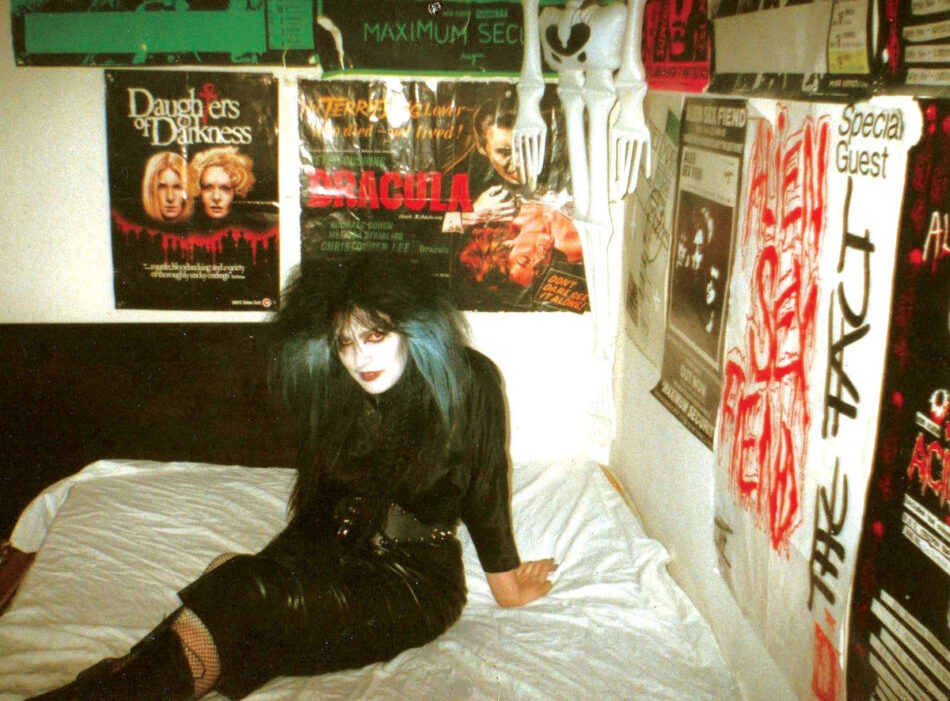Born Goth
The balloon frame, known for its ability both to fly away and to burst, is an outdated building technology from the 19th century. It was developed with the aim of being light, portable, easily erected, and, most importantly, parasitic. Walls were hung over a hollow frame in a simple, swift method, and the home was slowly demarcated, creating a boxlike environment. Reflecting a new standardization of materials, the resultant type of ur-American home relayed all structure to the perimeter, creating a free interior that hemmed its inhabitants and their identities within.
In the 1930s, Frank Lloyd Wright began developing his Usonian houses by manipulating the balloon frame, economizing it by removing structurally redundant studs. Designed during the Great Depression to provide affordable housing to a country in crisis and its growing middle class, Usonia was Wright’s failed plan to mass-produce the home. Its design reinforced the notion of a nuclear family, and later became a model for suburban allotments across America.
In Wright’s Usonian houses, there is nowhere to hide. The horizontal design, with its at roof overhang, eliminates both the attic and the basement. Meanwhile, the walls create boundaries outlining the borders of traditional relationships by allocating more square footage to the father-as-provider and the mother-as-caretaker, while the dutiful son and chaste daughter are given the least amount of space.
And while the identities of mother and father remain relatively fixed, when their child hits puberty, body and identity go into crisis. Suddenly growing hair, contending with skin breakouts, and waiting for genitalia to develop. Without a space to rebel, teenagers blow up the balloon frame, taking down Usonia and the notion of the reproductive family.
Mutter und Vater represent the barrier between the teenager and mass society. They remind our teen selves of our limited agency. Transmitting more than just complex data as DNA, parents pass down programmed behaviors that reproduce, among other things, a dominant culture. But times change, economies rise and fall, and the promise of stability becomes obsolete in the age of super viruses and global crises. The rigidity of norms and preestablished hierarchies are rejected, and the suburban habits that used to dictate teenage existence are constantly rethought.

Perpetually shoplifting identities, teens become authenticity machines, proving who they are by buying into an aesthetic. This is the Hot Topic ideology in which corporate interest controls trending individualism. Teens dress in the drag of their preferred subculture: goth, with piercings and dyed hair, or skater, emo, fuckboi, to communicate their dissent via outward signifiers. The desire for authenticity scars their smooth skin and plasters their desktops with screenshots of the aspirational demigods they consume and embody. This consumption of identity is a pattern of behavior symptomatic of suburbia, as the home and the highways that connect it to the city shut the teen body out of an expressiveness and freedom. Identity becomes not just a lifestyle but the source—you are not only a goth, you were born goth. Accordingly, manufacturing authenticity and the idea of a true self becomes the antidote to the prosumption disease.
Goth presented itself as a new potentiality in the early 1970s. Coined by journalists to describe a subculture emerging from marginalized scenes in London, it attracted both sexes as a kind of “positive punk” that eschewed the misogyny of many teen tribes. For the American teen, the Bowie-like glam and mystic elements were imports that filled the void of the consummate outsider. These kids were strangers standing on the fringe of mass society, beleaguered by anomie, striving for a sense of individuality that would subsume their need to belong. The balloon frame hardware was transposed onto teens’ clothing, with studs elevating the shoulders of leather jackets or spikes ringing their necks.
Just as the Visigoths took down the Roman Empire, goth broke the hegemony of parent culture and challenged the false idol of punk. With faces powdered white and hair night black, the aesthetic drew inspiration from Gothic literary traditions, stories of vampires, and 1970s horror films. The obsession with the undead is a direct reference to the death of a previous self: once dead you can become again. The search for an alternative family illustrates the ultimate withdrawal. Goth became cultural suicide.

The fantasy of withdrawal, of dropping out, is epitomized in how teens push and create space. Protesting their families’ private pathologies, they seek out basements, garages, and bedrooms in which to hide and redefine themselves. Without a sanctuary to be themselves, youth escape the balloon frame by slipping through its walls, occupying the in-between where they can manifest their hostility toward the structures that represent the indulgences of the bourgeoisie. This threshold is a delirious reality: teens become the product and creators of what they protest.
Now teens engage with a physical as well as a virtual space, using both to redefine the roles prescribed by their families and to designate areas in which to be themselves. As teens contest hierarchies at home and school, the same power structures limit them on the Web—just corporatized and better disguised. Authenticity of self and experience that the teen user so desperately seeks is one long, lit advertisement.
The violence of gentrification demands that the marketing power of the “authentic” be defied. Spaces to hide and become, spaces that provide escape from Usonian ideals—the clubs, warehouses, and basements where kids converge—need protection. Gentrification exploits these havens for their countercultural value, con- stantly erasing them in favor of the mainstream.
The essence of youth is the ability to murder nostalgia, to constantly forge and erect new identities that flow out of the balloon frame and into the city, injecting new life into dead space. After death comes reincarnation. We advocate for spaces constantly open to revision, defying the legislature that tries to define bodies based on a past. No longer performing, we are embodying; no longer projecting, but constructing. Western ego is oriented toward total alienation and disconnection; as such, radical empathy and inclusion are the tools through which we can break with the cultures of consumption. To remain in a state of transition, one of becoming, is the ultimate form of protest.
Olivia Erlanger is a sculptor based in New York City. Recent projects include “The Oily Actor” at What Pipeline, Detroit (2016); “Dripping Tap” at Mathew Gallery, New York (2016); and “a. or fifty thousand” at 83 Pitt Street, New York (2017). She recently published Hate Suburbia (2016) with Luis Ortega Govela, with whom she is currently directing a documentary on contemporary American suburbia.
Luis Ortega Govela is a Mexican architect and artist based in Los Angeles. He is cofounder of ÅYR, an art collective that explores the complex evolution of the home and domesticity today. The collective has exhibited internationally; recent shows include “Home Visit,” Museum Ludwig, Cologne (2016); and “I’d Rather Be Outside,” Stedelijk Museum, Amsterdam (2017). He coauthored, with Olivia Erlanger, Hate Suburbia (2016), a book on the architecture and image of the garage, and is currently directing a film with Erlanger on contemporary American suburbia.
